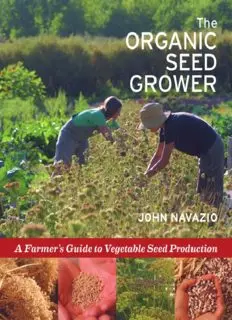
The Organic Seed Grower: A Farmer's Guide to Vegetable Seed Production PDF
Preview The Organic Seed Grower: A Farmer's Guide to Vegetable Seed Production
PRAISE FOR THE ORGANIC SEED GROWER “JOHN NAVAZIO HAS WRITTEN A FANTASTIC GUIDE FOR ORGANIC SEED BREEDERS AND PRODUCERS. HE HAS TAKEN ORGANIC SEED PRODUCTION TO A HIGHER LEVEL WITH EXTENSIVE INFORMATION ON SELECTION, GENETIC INTEGRITY, ISOLATION DISTANCES, AND SEEDBORNE DISEASES. ALTHOUGH HIS FOCUS IS ON PLANT BREEDERS AND COMMERCIAL GROWERS, MUCH OF THE INFORMATION IS ALSO APPLICABLE TO SMALL-SCALE FARMS PRODUCING SEED FOR ON-SITE USE.” —SUZANNE ASHWORTH, author of Seed to Seed “John Navazio has made a keystone contribution to the future of the grassroots organic seed movement. The Organic Seed Grower is a fundamental resource for the preservation and improvement of agricultural biodiversity. It is an essential guide to high-quality, organic seed production: well grounded in fundamental principles, brimming with practical techniques, thorough in coverage, and remarkably well organized, accessible, and readable.” —JEFF MCCORMACK, PhD, founder of Southern Exposure Seed Exchange “With The Organic Seed Grower, well-respected plant breeder and seed expert Dr. John Navazio has written the definitive book on organic vegetable seed production. Encyclopedic, yet well written and approachable, this seminal work deserves a place in every grower’s library. From the organic farmer seeking a comprehensive reference, to the family farmer who wants to learn how to guarantee access to a favorite variety, to the progressive seed saver committed to success—all will find this book an indispensable guide and Navazio a trusted partner in organic seed improvement.” —JIM GERRITSEN, president, Organic Seed Growers and Trade Association (OSGATA) “There is nothing more important right now than growing and saving seeds—that most essential aspect of life. While we may have all done this once upon a time, we have mostly lost these skills to private industry or urbanization. Until now. John Navazio reveals all the techniques and tricks, some simple and some complex, that he’s learned only after decades of careful observation and practice. Incredible photos help tell the story of life that seeds represent. The Organic Seed Grower is what we need to take back community control of seeds from those who have taken it from us.” —TOM STEARNS, president, High Mowing Organic Seeds The Northeast Sustainable Agriculture Research and Education (SARE) program is a USDA competitive grants program, and grant funds have supported the writing, editing, and production of this book. Northeast SARE invests in projects like this one to improve the understanding and adoption of sustainable farming techniques. SARE defines sustainable farming as profitable, environmentally sound, and good for communities. There are four SARE regions that serve the United States and the Island Protectorates. The Northeast SARE region is made up of Connecticut, Delaware, Maine, Maryland, Massachusetts, New Hampshire, New Jersey, New York, Pennsylvania, Rhode Island, West Virginia, Vermont, and Washington, D.C. To learn more about SARE and the grant offerings in each of the four SARE regions, go to www.sare.org. Copyright © 2012 by John Navazio. All rights reserved. All photographs © Scott Vlaun unless otherwise credited. No part of this book may be transmitted or reproduced in any form by any means without permission in writing from the publisher. Project Manager: Patricia Stone Developmental Editor: Ben Watson Copy Editor: Laura Jorstad Proofreader: Eileen M. Clawson Indexer: Margaret Holloway Designer: Melissa Jacobson Printed in the United States of America First printing November, 2012 10 9 8 7 6 5 4 3 2 1 12 13 14 15 16 Our Commitment to Green Publishing Chelsea Green sees publishing as a tool for cultural change and ecological stewardship. We strive to align our book manufacturing practices with our editorial mission and to reduce the impact of our business enterprise in the environment. We print our books and catalogs on chlorine-free recycled paper, using vegetable-based inks whenever possible. This book may cost slightly more because it was printed on paper that contains recycled fiber, and we hope you’ll agree that it’s worth it. Chelsea Green is a member of the Green Press Initiative (www.greenpressinitiative.org), a nonprofit coalition of publishers, manufacturers, and authors working to protect the world’s endangered forests and conserve natural resources. The Organic Seed Grower was printed on paper supplied by QuadGraphics that contains at least 10% post-consumer recycled fiber. Library of Congress Cataloging-in-Publication Data Navazio, John. The organic seed grower : a farmer's guide to vegetable seed production / John Navazio. p. cm. Includes bibliographical references and index. ISBN 978-1-933392-77-6 (hardcover)—ISBN 978-1-60358-452-4 (ebook) 1. Vegetables—Seeds. 2. Vegetables—Propagation. 3. Vegetables—Organic farming. 4. Organic farming. 5. Seed technology. I. Title. SB324.75.N38 2013 635—dc23 2012034338 Chelsea Green Publishing 85 North Main Street, Suite 120 White River Junction, VT 05001 (802) 295-6300 www.chelseagreen.com 1. Cover 2. Contents 3. Introduction 4. Acknowledgments 5. Part 1 6. 1. A Short History of Agricultural Seed 7. 2. Reproductive Biology of Crop Plants 8. 3. Understanding Biennial Seed Crops 9. Part 2 10. 4. Alliaceae 11. Leek 12. Onion 13. 5. Amaranthaceae 14. Garden Beet 15. Spinach 16. Swiss Chard 17. 6. Apiaceae 18. Carrot 19. Celery & Celeriac 20. Cilantro 21. Parsley 22. Parsnip 23. 7. Asteraceae 24. Chicory 25. Endive & Escarole 26. Lettuce 27. 8. Brassicaceae 28. The Cole Crops 29. Mustard Greens 30. Radish 31. Rutabaga & Siberian Kale 32. Turnip & Asian Greens 33. 9. Cucurbitaceae 34. Cucumber 35. Melon 36. Squash 37. Watermelon 38. 10. Fabaceae 39. Common Bean 40. Edamame 41. Fava Bean 42. Garden Pea 43. Lima Bean 44. Runner Bean 45. 11. Poaceae (Sweet Corn) 46. 12. Solanaceae 47. Eggplant 48. Pepper 49. Tomato 50. Part 3 51. 13. Isolation Distances for Maintaining Varietal Integrity 52. 14. Maintaining Adequate Population Size 53. 15. Seed Crop Climates 54. 16. Seedborne Diseases 55. 17. Stockseed Basics 56. About the Author 57. More Books by Chelsea Green – Introduction –
